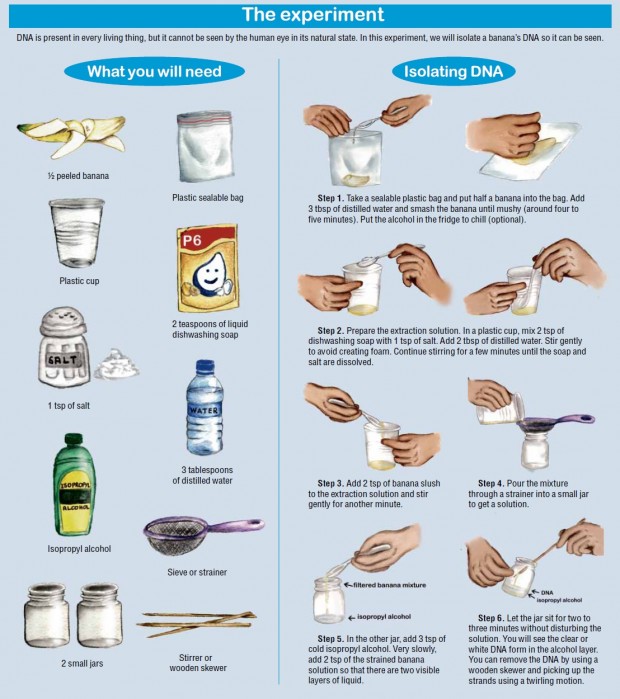What makes you unique?
Take a look at your friends and try to compare. Do they all look the same? Do they look like you?
People have different features—skin color, ear shape, nose size, even eye color. What makes each person unique? The answer is DNA or deoxyribonucleic acid.
DNA is a special molecule that tells your cells what to do. You have billions of cells in your body that are too tiny to see. Each cell has its own job. Inside cells are tiny structures called chromosomes and inside every chromosome are hundreds of genes.
DNA is like a beautiful ladder twisted many times. Its shape is called a double helix. It is arranged into a structure of 46 chromosomes. Your chromosomes are arranged in pairs. You inherit one copy of the pair from your mother and the other from your father.
About the series
Article continues after this advertisementAre you one of those students who are afraid of Science? Do you think there is no fun in learning Science?
Article continues after this advertisementIn keeping with its mission, “Bayer: Science for a Better Life,” and its enthusiasm for research, Bayer wants to pass on to young people like you the joy in discovery and the excitement in learning. By putting together simple, educational and fun experiments, Bayer encourages elementary school students to learn Science by doing Science.
The Bayer Smiling Kiddie Einsteins series offers students, teachers and even parents hands-on and inquiry-based experiences that involve observing, hypothesizing, analyzing and testing.
Through this series of experiments related to health, nutrition and nature, Bayer and Inquirer in Education aim to deepen the interest of elementary pupils in Science.
The materials needed for these experiments are safe and can easily be accessed from your home.
The experiment
DNA is present in every living thing, but it cannot be seen by the human eye in its natural state. In this experiment, we will isolate a banana’s DNA so it can be seen.
What you will need
½ peeled banana
Plastic sealable bag
Plastic cup
2 teaspoons of liquid dishwashing soap
1 tsp of salt
3 tablespoons of distilled water
Isopropyl alcohol
2 small jars
Sieve or strainer
Stirrer or wooden skewer
Isolating DNA
Step 1. Take a sealable plastic bag and put half a banana into the bag. Add
3 tbsp of distilled water and smash the banana until mushy (around four to five minutes). Put the alcohol in the fridge to chill (optional).
Step 2. Prepare the extraction solution. In a plastic cup, mix 2 tsp of dishwashing soap with 1 tsp of salt. Add 2 tbsp of distilled water. Stir gently to avoid creating foam. Continue stirring for a few minutes until the soap and salt are dissolved.
Step 3. Add 2 tsp of banana slush to the extraction solution and stir gently for another minute.
Step 4. Pour the mixture through a strainer into a small jar to get a solution.
Step 5. In the other jar, add 3 tsp of cold isopropyl alcohol. Very slowly, add 2 tsp of the strained banana solution so that there are two visible layers of liquid.
Step 6. Let the jar sit for two to three minutes without disturbing the solution. You will see the clear or white DNA form in the alcohol layer. You can remove the DNA by using a wooden skewer and picking up the strands using a twirling motion.
The Science
Here’s what happened:
The long thick fibers you pulled out of the extraction solution are strands of banana DNA.
DNA is present in every cell of plants and animals. It is tightly packaged inside the nucleus of cells. The membranes of the cell and the nucleus are rich in fats, so we can break them down using dishwashing soap. The salt is added to break up protein chains that hold nucleic acids together, releasing the DNA strands.
DNA dissolves in water but not in alcohol. So when we add alcohol to the extraction solution, the DNA collects as a white mass at the top of the solution.
Fun DNA facts
Did you know that…
Identical twins have the same DNA because they come from the same egg, which divides into two embryos after it is fertilized. They are always the same sex and they always have the same blood type—though their fingerprints will differ. Twins who are not identical (fraternal twins) do not carry the same DNA.
You can fit 25,000 strands of DNA side by side in the width of a single adult hair.
We are 99.9 percent alike. The 0.1 percent of difference in DNA makes us unique.
A parent and child share 99.5 percent of the same DNA.
Using the newspaper
Just as each person has a unique DNA, everyone has his or her own story. Sometimes the story lands a person in the newspaper.
Look in the Inquirer and cut out pictures of five people. They can be movie stars, politicians, athletes, even not-so-famous people.
Paste the photos on a sheet of paper.
Under each picture, write a caption that includes the name of the person and why each is in the news today.
